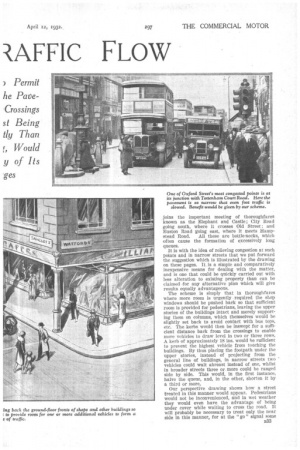EXPEDITING r AFFIC FLOW N 0 one will deny that the
Page 50

Page 51

Page 52

If you've noticed an error in this article please click here to report it so we can fix it.
traffic problem in London and other large cities is of such vast importance, and is responsible for the loss of such huge sums of money through the delays and slowing down caused by congestion, that drastic measures are,required to deal with it. The widening of streets, the construction of tunnels and other expensive methods of alleviating the trouble have been put forward from time to time, but in these days of high taxation and the need for national economy one hesitates to suggest any elaborate plan which will necessarily entail the expenditure of enormous sums of money. Yet, to ensure that traffic will move more freely and to prepare for the increase which is certain to follow as business improves, it is obvious that timely measures must be taken.
The main points at which delays are liable to occur are where thoroughfares cross each other, and here the queues appear to be getting longer and longer. Consequently, the vehicles constituting them take more time to get through—so long, in fact, that in many cases the vehicles at the ends of the queueSare held up for second periods of non-movement. This is particularly noticeable where traffic signals are employed, because the time of crossing in each direction is necessarily, although from many points of view advantageously, decreased.
The opening up of suitable parallel thoroughfares has been suggested, but this plan, to some extent, defeats its own object, as it automatically increases the number of crossings, and, consequently, there must be more stoppages of the lines of traffic at these places; apart from these points, few of such parallel thoroughfares themselves have adequate traffic capacity without expensive widening and other attention.
It is a curious feature of London's somewhat straggling layout that so many main thorough.fares narrow down to bottle-necks where important crossings are encountered. Instances of these can be found at the end of Walworth Road, where it B32 joins the important meeting of thoroughfares known as the Elephant and Castle ; City Road going south, where it crosses Old Street ; and Ruston Road going east, where it meets Hamp stead Road. All these are bottle-necks, which often cause the formation of excessively long queues.
It is with the idea of relieving congestion at such points and in narrow streets that we put forward the suggestion which is illustrated by the drawing on these pages. It is a simple and comparatively inexpensive means for dealing with the matter, and is one that could be quickly carried out with less alteration to existing property than can be claimed for any alternative plan which will give results equally advantageous.
The scheme is simply that in thoroughfares where more room is urgently required the shop windows should be pushed back so that sufficient room is provided for pedestrians, leaving the upper stories of the buildings intact and merely supporting them on columns, which themselves would be slightly set back to avoid contact with bus tops, etc. The kerbs would then be inswept for a sufficient distance back from the crossings to enable more vehicles to draw level in two or three rows. A kerb of approximately 18 ins, would he sufficient to prevent the highest vehicle from touching the buildings. By thus placing the footpath under the upper stories, instead of projecting from the general line of buildings, in narrow streets two vehicles could wait abreast instead of one, whilst in broader streets three or more could be ranged side by side. This would, in the first instance, halve the queue, and, in the other, shorten it by a third or more.
Our perspective drawing shows how a street treated in this manner would appear. Pedestrians would not be inconvenienced, and in wet weather they would even have the advantage of being under cover while waiting to cross the road. It will probably be necessary to treat only the near side in this manner, for at the " go " signal some vehicles would turn the corner, whilst others could accelerate more rapidly, so that a "three-abreast " would soon thin down to "two-abreast." The additional vehicle or vehicles in line could also filter to the left at crossings where this is permissible, and thus assist in reducing the congestion and enable a closing-up of the queue.
Compensation would necessarily have to be paid to the owners of the property concerned, but it would be small in comparison with that entailed in the pulling down and rebuilding of an entire structure. Apart from this, the value of the upper storeys would not be reduced.
The plan may not be perfect, critics will, no doubt, find certain defects in it, but it may well form the basis of a much-needed improvement.
The mere fact that the queues of waiting vehicles would be shortened would enable them to be cleared more rapidly, and this without reducing the degree of safety to traffic and pedestrians.




































































































